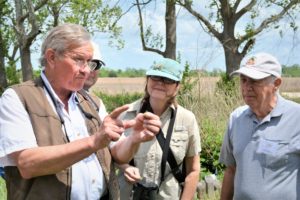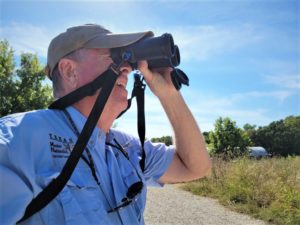Texas Master Naturalists volunteer above and beyond
Program’s popularity, volunteer opportunities skyrocketing
Texas Master Naturalists accumulate volunteer hours in as many ways as there are personalities and preferences within the program’s 48 chapters across the state.

The Coastal Prairie chapter in Rosenberg, with almost 200 members, is one example of where and how volunteers are shining in their communities by following a passion.
For vice president and new class director Shannon Westveer, turning recruits into Texas Master Naturalists program members through coursework, field instruction and the certification process represents up to 800 volunteer hours per year.
But her true passion is working with elementary-school aged children. Soon, Westveer will collaborate with the Fort Bend Independent School District, where her children attended, to work with administrators, faculty, staff and students’ parents to turn campus spaces into nature spaces for hands-on teaching opportunities.
Texas Master Naturalists volunteerism
The Texas Master Naturalist program began statewide in 1998 as a joint effort between Texas A&M AgriLife Extension Service and Texas Parks and Wildlife Department. Its mission is to provide education, outreach and service dedicated to the management of natural resources throughout the state.
The program provides an opportunity for interested and concerned adult residents to learn more about the natural environment around them and to improve their communities.
Some Master Naturalists across the state volunteer as docents at parks and natural areas or install native pollinator gardens in public spaces. Some dedicate their efforts to riparian ecosystems to improve water quality in recreational and fishing lakes or avian-related efforts to improve birding and native bird habitats in their area.
While required to volunteer to remain active in the program, Westveer said volunteers are better served and serve better by following their passion. She said many volunteers go above and beyond their minimum volunteer service requirements, with some incredible few volunteers providing over 20,000 volunteer service hours during their history with the program.
“As a volunteer, the trick is to follow your interests and passion,” she said. “I want to connect kids with nature and give them something they can see and touch that will tie into what they are learning in books.
“The great thing about the Master Naturalists is that you can participate in established programs or create something new to serve your community and there is an entire support system already in place to help guide you toward success.”
Texas Master Naturalists “learn here, give here”

Mary Pearl Meuth, AgriLife Extension’s Texas Master Naturalist assistant state coordinator, and Michelle Haggerty, Texas Parks and Wildlife Department’s state coordinator, jointly manage the program’s activities and co-produce the program’s statewide curriculum, which includes subjects such as geology, ornithology and wetland ecology.
Meuth said Texas Master Naturalists chapters and members follow a “learn here, give here” model that provides education for members, outreach to the public and services for communities where the chapters are located.
Participants must complete a minimum of 40 hours of natural resource training, 40 hours of service and eight hours of advanced training through the program within their first year to become a Texas Master Naturalist.
County-based chapters recruit and train participants through a series of intensive field- and classroom-based curriculum and hands-on activities in local ecosystems, Meuth said. Recruits are then asked to provide 40 hours of service on behalf of the chapter. This might include removing invasive flora, providing ecosystem stewardship services or performing technical projects related to improving natural resources.
“Texas Master Naturalists come from every background and walk of life, but two things I think are consistent among everyone is that they want to improve their knowledge about the natural world and continue to grow through experience and fellowship with others around the learning opportunities provided,” she said.
Program popularity on the rise
This past year, Texas Master Naturalists from the 48 chapters in Texas counties provided 442,595 volunteer hours, valued at more than $10 million to their communities, Meuth said. Since the Texas program’s inception, Master Naturalists have volunteered almost 6 million hours in communities and ecoregions across the state with a value of more than $131 million.
Meuth said the program has seen an influx of diverse ages and backgrounds among new members.
Texas chapters added 474 new members in 2021, pushing the total number of Texas Master Naturalist beyond 15,000. Chapter programs reached more than 137,000 youth and adults, including private landowners. Additionally, two new chapters are going through the review process to bring the number to 50 chapters statewide.
Meuth believes public interest in the program, recruiting and participation by volunteers has “skyrocketed” over the past two years due to COVID-19 restrictions. Volunteer hours also increased precipitously during the pandemic.
“I think the lockdown restrictions made people want to seek opportunities outdoors and to make a difference in their community — or they were just looking around their homes and wanted to know more about the environment around them,” Meuth said. “Becoming a Master Naturalist gives people all those things, but it also gives them the opportunity to join a community that actively enjoys nature, shares knowledge and passions, and improves their local communities through volunteerism.”
More accessibility to training, membership
The pandemic also changed how the coursework requirements could be met, and the result has opened the program to more age groups, Meuth said. In the past, training classes were mostly on weekdays, which excluded much of the working population. Curriculum is now shifting toward training times that are more accessible to the working public. There are also hybrid learning opportunities with virtual and classroom coursework accompanied by field training.
“We’ve worked hard to change the training models and encourage expanding training opportunities for working and non-working people and also to college students,” she said.
Beyond the knowledge the course provides, Meuth said the program provides connectivity and community. The network of Master Naturalists across the state and nation provides an engagement opportunity that many members find appealing.
Meuth said the goal for the program going forward is to accommodate as many recruits as possible without compromising the classroom and experiential training.
As increasing popularity pushes the Texas Master Naturalists program’s boundaries, scientific progress continues to blaze new discoveries and ultimately learning opportunities for its members, Meuth said. Scientific discoveries and deeper explorations into the complexities of plant and animal species and their interaction with ecosystem that support them makes this an exciting time to be a Master Naturalist.
“It’s exciting and humbling to see how much we are learning and how much we still don’t know about the natural systems around us,” she said. “It makes exploring the natural world a constantly evolving adventure, and the ability to pass along your passion and knowledge as a Master Naturalist that much more rewarding.”


